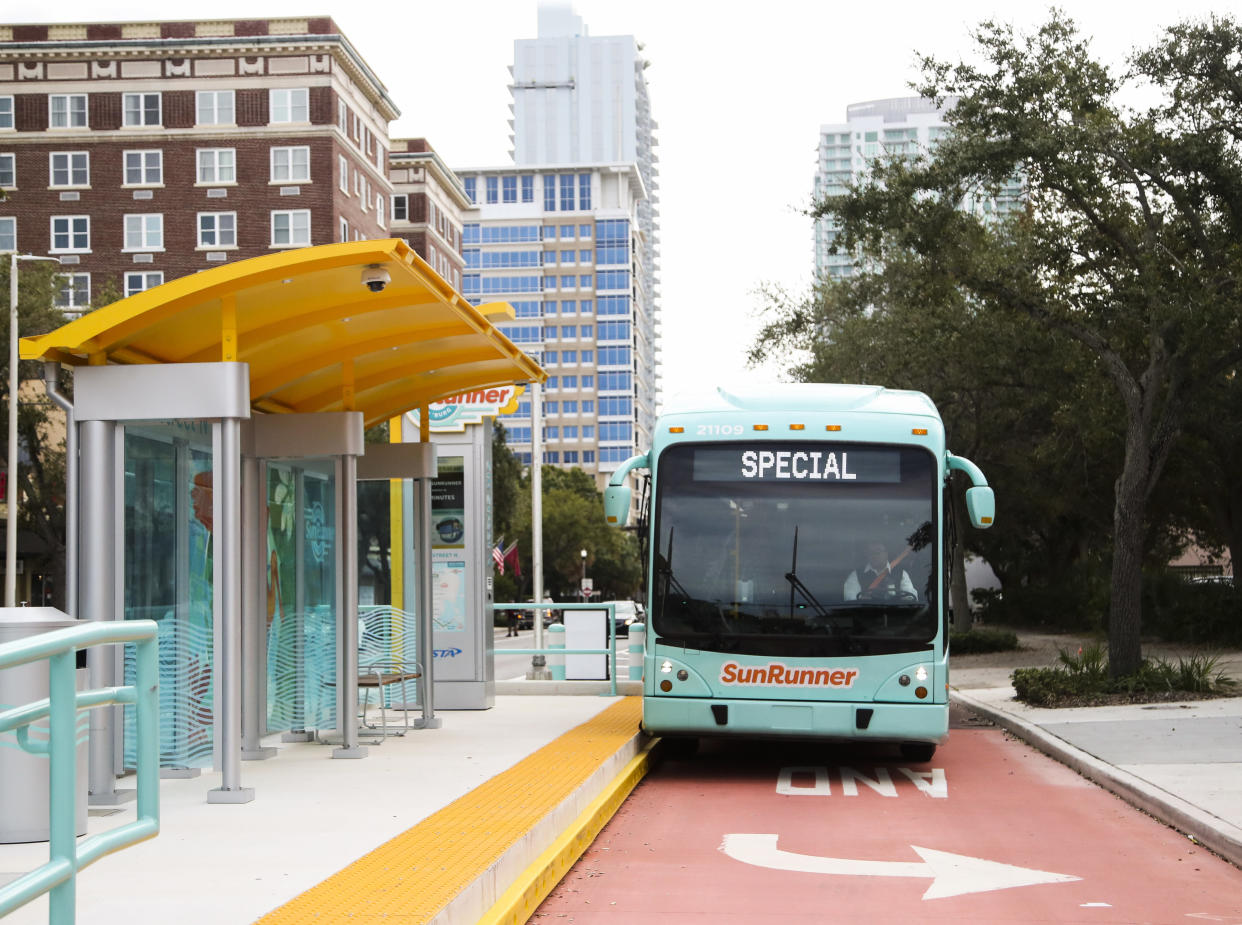Studies find new St. Petersburg bus lanes cause no car commuter harm

When the SunRunner rapid bus line debuted last year, Brad Miller, the CEO of Pinellas County’s transit authority, promised that it wouldn’t be “your grandmother’s bus service,” that it would get people where they wanted to go, and fast.
What he’s heard back is lawmakers in Tallahassee telling him that the rapid bus service along First avenues North and South and Pasadena Avenue threaten the commute times and safety of drivers.
A pair of studies by outside groups, though, found that the lanes are working as intended without affecting car traffic. One showed that commute times along one segment of the bus route have hardly changed, even speeding up slightly. And crashes along the entire corridor are down markedly.
“I constantly heard, when I was up there, the opposite of what these studies have shown,” Miller said in a Nov. 15 meeting of the Pinellas Suncoast Transit Authority’s planning committee.
State Rep. Linda Chaney, a St. Pete Beach Republican, is the sponsor of a bill that would shrink the Transit Authority’s board of directors and put new hurdles and limitations on its policymaking. She’s said she was driven in part by constituents’ complaints about the bus lanes.
Talking about Chaney’s bill at a legislative delegation meeting in November, state Sen. Ed Hooper, R-Clearwater, groused about lane eliminations. So did Rep. Berny Jacques, R-Seminole, who said he’d spent a lot of time driving on the First avenues as a Stetson University College of Law student — he graduated more than a decade ago — and considered the lane reduction a “travesty.”
“It doesn’t make any sense,” he said, before suggesting that the Transit Authority, which moved more than 10 million passengers last year, get rid of its buses in favor of ride-share vouchers.
The study on travel times was performed by the state’s Department of Transportation. It found almost no difference between traffic speeds and travel times on Pasadena Avenue before and after a lane in each direction was dedicated to buses and vehicle turns.
Another report from Forward Pinellas, the county’s land use and transportation planning agency, compared crashes along the SunRunner route in the year before and the year after it launched. It found they declined from more than 800 in the earlier period to fewer than 600 in the latter, with fatal collisions dropping from six to three.
Whit Blanton, the executive director of Forward Pinellas, said the lanes are working as intended. While giving a leg up to public transit users in a small section of the county, they’ve also forced drivers to operate more carefully without causing congestion problems.
Concerns that lane changes or reductions will worsen traffic are common, Blanton said, but such fears rarely come to pass. That’s in part because people are adaptive. They figure out the fastest way to get from point A to point B, even if that means changing their route, leaving at a different time or taking the bus instead of driving.
Those experiencing the most difference on the First avenues may be those who were once comfortable driving 10 or 15 mph over the posted speed limit, Blanton said.
“When you have fewer lanes, the prudent driver controls the flow,” he said. “People are getting back to the speed limit.”
Chris Steinocher, the president of the St. Petersburg Chamber of Commerce, said the bus-and-turn lanes have turned the First avenues from “raceways” into the kind of safer, slower streets that benefit local commerce.
That Steinocher has become a proponent of his city’s roadway changes — including bike-lane additions on Dr. Martin Luther King Jr. St. — surprises him as much as anyone. When he first heard the pitch for reducing lanes for cars, he said, he feared they’d disrupt what he calls St. Petersburg’s “magic”: the grid system that helps keep it relatively free of intracity traffic jams.
“I was going to prove to everybody that it doesn’t work,” he said.
But he was swayed by researching road-space reallocation, which international studies have found often decreases traffic rather than exacerbating it. Steinocher is no evangelist for widespread lane elimination, he said. But he believes that in St. Petersburg lane elimination has encouraged bicycle and transit use and forced drivers to pay more attention, which in turn gets people to notice — and spend their money at — local businesses.
Both Blanton and Steinocher said they believe people whose experiences diverge from what the data says is the overall picture, but they believe that to be the exception or that the increase in drive time is nominal.
“I do believe that people feel like their commute has changed, and it has added some kind of frustration or some kind of time element,” said Steinocher, whose wife owns a business near the west end of First Avenue South. “Our personal anecdote is, does it add maybe a minute or two? Yes, I think it does. There is not what many cities would consider traffic caused from this.”
Some residents have accused the Transit Authority of a campaign to cut lanes, and Chaney has referred to a “massive lane elimination” planned across Pinellas. But the bus-and-turn lanes along the SunRunner corridor are the only ones of their kind in the county, Blanton said. One more is planned and currently under construction on part of 34th Street South, but no others are in the works anytime soon.

